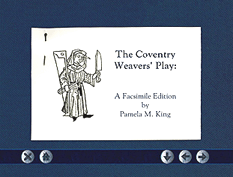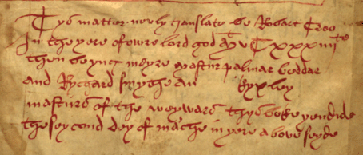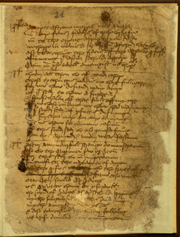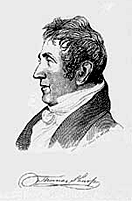Only two play-texts are known to have survived from Coventry’s famous and once-comprehensive
cycle of late medieval mystery plays, - the Pageant of the Shearmen and Taylors
which covers the Nativity story from the Annunciation to the Massacre of the Innocents,
and
- the Weavers’ Pageant which follows on with the Purification of the Blessed Virgin
Mary and Presentation of Christ in the Temple, and Christ and the Doctors.
The Weavers’ Pageant exists in two manuscripts, Coventry City Record Office Accessions
11/1 and 11/2. The manuscript of the Shearmen and Taylors’ pageant was destroyed in the fire
at the Birmingham Free Reference Library in 1879, but fortunately a printed transcript of it
had been published by the Coventry antiquarian Thomas Sharp in a limited edition in 1817,
and in his Dissertation on the Pageants or Dramatic Mysteries Anciently Performed at
Coventry in 1825.
 |
The CD-ROM of the Coventry plays
will reproduce high quality
photo-facsimiles of these two surviving manuscripts of the Weavers’ pageant, as well as
related manuscript and printed materials, including both versions of Sharp’s editions of
the Pageant of the Shearmen and Taylors, complete with the words of the Coventry Carol and
other songs. |
| The Manuscripts |
| Coventry Record Office Accession 11/2 is the base text of the
Weavers' pageant, prepared for the guild in 1534 by Robert Croo at a cost of five shillings.
On the penultimate page of the manuscript there is the following colophon: |
 |
Tys matter nevly translate be Robert Croo/
In the yere of owre lord god M1vCxxxiiijte
/
then beyng meyre Mastur palmar beddar/
and Rychard smythe an ... Pyxley/
masturs of the
weywars thys boke yendide/
the seycond dey of marche in yere above seyde. |
 |
Coventry Record Office Accession 11/1 is two leaves from an earlier
version of the Presentation in the Temple, written in a fifteenth-century secretary hand in
brown ink, on two leaves of handmade paper. Croo seems to have been working from this original
for the first half of the play at least. These pages show all the signs of being fragments
of an earlier prompt copy.
Other Coventry Manuscript Records on the Plays
The survival of these two manuscripts, plus six fifteenth-century deeds pertaining to the land
on which the Weavers' pageant house was built, the ordinances of the guild dated 31 Henry VI
(1 September 1452 - 31 August 1453), account books from 1523, rent-gatherers' accounts from
1521, and registers of apprentices from 1550 - 1700, mean that the records of the Coventry
Weavers' are extensive, if not always informative, for the period in which the play was
performed. |
The package has been designed in such a way that the user can move
easily from manuscript to manuscript, calling up as much help in the way of codicological and
background information, as well as transcriptions of the texts, as (s)he needs, on screen.
It will accordingly be useful both to experienced scholars and to students who have never worked
with manuscripts before. The former will have unimpeded access to the manuscripts in their
studies, and the latter will be able to call up the support they need to experience and
understand a medieval manuscript at first hand.

The playbook is sprinkled with interesting marginalia offering tantalising
glimpses of its early use. Even its binding reveals secrets: the pastedowns,
now bound-in as fly-leaves, are ff. v, ii, a woodcut, and f.vii of an edition of the Expositio
hymnorum secundum vsum Sarum, printed by Pinson in 1498. The package allows the user to
reconstruct them in their original position complete with graffiti.
Later History of the Manuscripts
With the demise of Candlemas as a liturgical feast of any importance after the Reformation, the
subject matter of the Weavers’ pageant lost interest. Consequent neglect meant that the
manuscripts survived quietly in the continuous possession of the guild, latterly known as the
Company of Broadweavers and Clothiers, who are still the owners.
The other more popular materials from the Coventry cycle, including the Pageant of the Shearmen
and Taylors, which is a long Nativity play, passed into the Staunton Collection at Longbridge
House, and from there to the Free Reference Library of Birmingham, where they perished in a fire
in 1879.
|
Thomas Sharp, Coventry’s early nineteenth-century antiquarian,
an assiduous transcriber (and hero of the Directors of the Project) is solely responsible
for the survival of all the other materials we have relating to the Coventry cycle. He published
the Pageant of the Shearmen and Taylors twice, first on its own in 1817 in a limited edition of
12 copies only, then in his Dissertation on the Pageants or Dramatic Mysteries anciently
performed at Coventry (Coventry: Merridew, 1825). He discovered the Weavers' pageant
and records too late for their inclusion in the Dissertation, but later published it in an
Abbotsford Club edition of 1836. That text, the now rare 1817 text, and extracts from Sharp’s
personal annotated proof copy of his Dissertation, now in the British Library, are all
also digitally reproduced as part of the same package. |  |
© PAMELA M. KING 2000




